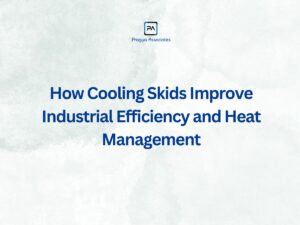Heat exchangers are like the unsung heroes of many industries, quietly transferring heat from one place to another. They are everywhere, from your car’s radiator to large industrial processes. However, their efficiency can make a big difference and plays a vital role in how well things work. Here in this blog post, we will explore the factors that affect the efficiency of heat exchangers.
- Surface Area: Heat exchangers are essentially devices designed to transfer heat from one fluid (or substance) to another. They come in various shapes and sizes, but their efficiency often depends on their surface area. Picture a heat exchanger as a large, flat sheet or panel. Just like a bigger sheet can absorb more spilt liquid, a larger heat exchanger has more space available for transferring heat. This extra space allows it to handle larger quantities of heat effectively, making larger heat exchangers a preferred choice when dealing with substantial heat loads.
- Temperature Difference: The primary purpose of a heat exchanger is to facilitate the exchange of heat between two substances – one hot and one cold. To explain this, think of a heat exchanger as a bridge connecting two towns. The faster you can travel between these towns, the more efficiently you can move goods and people. Similarly, in a heat exchanger, when there’s a substantial difference in temperature between the hot substance and the cold substance, heat transfers more rapidly. This temperature differential acts as a driving force, enhancing the heat exchanger’s effectiveness in transferring heat from one side to the other.
- Flow Rate: Heat exchangers rely on the flow of fluids to carry heat away from a hot substance to a colder one. Imagine a water pipe: if water flows through it slowly, it’s like a gentle stream, but if it rushes through rapidly, it’s like a powerful river. The same principle applies to heat exchangers. The flow rate of fluids impacts their ability to transfer heat. When fluids flow at a higher speed, they carry away heat more effectively, which is crucial for the heat exchanger to do its job well. Therefore, maintaining control over the fluid’s speed is a critical aspect of optimising a heat exchanger’s performance.
- Material Conductivity: Not all materials are created equal when it comes to conducting heat. Some materials are like great conductors, while others are more like heat blockers. Using materials with high thermal conductivity in a heat exchanger can make it more efficient because they transfer heat better. Imagine some materials as excellent conductors of heat, like speedy messengers delivering a message quickly, while others are like slow messengers. In a heat exchanger, using materials with high thermal conductivity is like choosing fast messengers; they transmit heat efficiently, making the heat exchanger more effective at its job.
- Fouling and Cleaning: Over time, stuff can stick to the inside of a heat exchanger, like gunk in a pipe. This is called fouling, and it reduces efficiency. Regular cleaning or maintenance helps keep the heat exchanger running smoothly. Over time, substances can build up inside a heat exchanger, similar to how dirt can clog a pipe. This buildup, known as fouling, hinders the heat exchanger’s efficiency. Regular cleaning and maintenance act like a clean-up crew, ensuring the heat exchanger runs smoothly and efficiently.
- Design and Configuration: Imagine building a house with lots of corners and dead-end rooms – it would be hard to move around. The same goes for heat exchanger design. A well-thought-out design with smooth, straight passages allows for better heat transfer and efficiency. Consider heat exchanger design like designing a house for easy movement. A well-planned design with smooth, straight pathways allows heat to flow easily, enhancing heat transfer and overall efficiency. In contrast, a design with lots of corners and dead-end pathways can be less efficient.
- Counterflow vs. Parallel Flow: Heat exchangers can be designed in different ways. Counterflow and parallel flow are two common types. In counterflow, hot and cold fluids flow in opposite directions, which can be more efficient. In parallel flow, they flow in the same direction. The choice depends on the specific application. Heat exchangers can be set up in different ways, similar to choosing different routes for a journey. In counterflow, hot and cold fluids move in opposite directions, which often boosts efficiency by maximizing heat transfer. In parallel flow, they move in the same direction, which suits some specific applications but may be less efficient for others. The choice depends on the particular needs of the heat exchange process.
Heat exchangers are essential for many processes, and understanding what makes them efficient is vital. Remember, a bigger surface area, a significant temperature difference, proper flow rates, good materials, regular cleaning, smart design, and the right flow configuration all contribute to better heat exchanger performance. By paying attention to these factors, industries can save energy, improve processes, and keep things running smoothly. Heat exchangers might work quietly, but their efficiency can make a loud difference.




